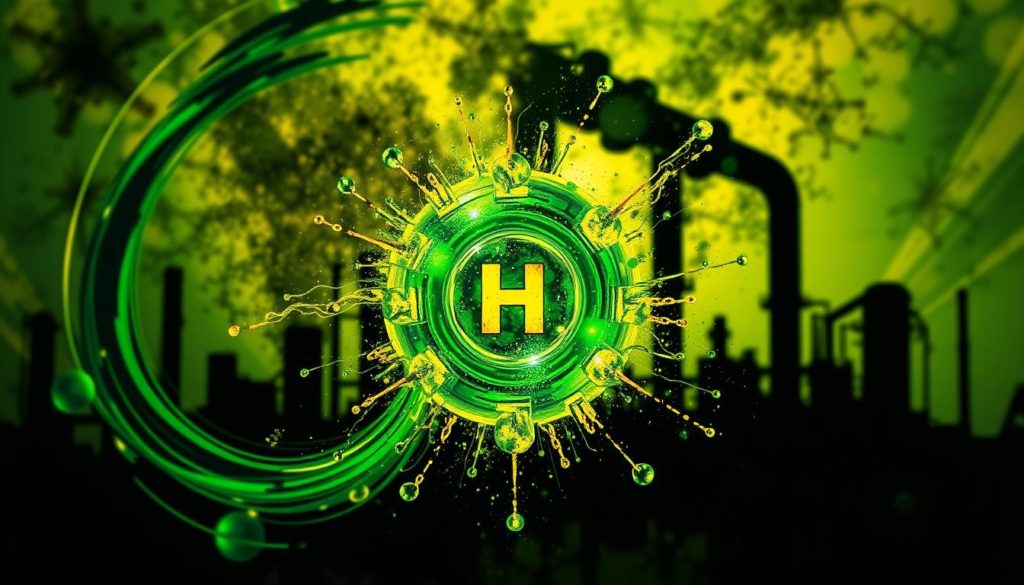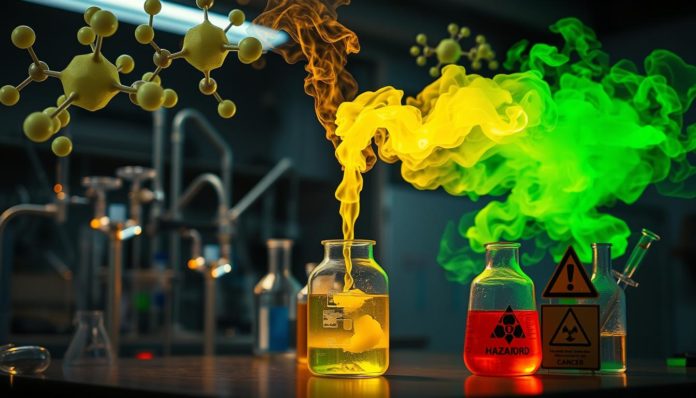Did you know about the environmental lawsuit involving hexavalent chromium? It was one of America’s most significant cases. The fight with Pacific Gas and Electric Company was shown in “Erin Brockovich.” It exposed high pollution levels in a community. This event brought attention to the cancer risk from chromium 6. Since then, public and scientific worries have grown. People are now more than ever interested in this harmful chemical and its impact.
Hexavalent chromium gets used a lot in different industries. This has caused widespread environmental pollution and health issues. The toxic nature of this compound is alarming worldwide. Health groups are looking into how it might cause cancer and other dangers. This article will cover these topics. We aim to provide a full look at chromium 6, its effects on health, and the environment.
What is Hexavalent Chromium?
Hexavalent chromium, often called hex chrome, is important in many areas. It’s known for being both valuable and dangerous due to its high toxicity levels. This makes it very interesting to scientists and industry experts.
Definition and Chemical Properties

Known as chromium(VI), hex chrome has an oxidation state of +6. This state gives it unique abilities, like dissolving easily in water. Its chemical properties make it useful but also risky.
Common Uses in Industry
Hex chrome is widely used in industries. It’s crucial for chrome plating, which fights corrosion and adds shine to products. This chemical also brings out vivid colors in dyes and paints, making them last longer.
Its use doesn’t stop there; hex chrome also makes stainless steel stronger and more durable. However, its toxic nature means it must be handled with care. Regulations are in place to keep workers and the environment safe.
- Chrome Plating: Offers corrosion resistance and aesthetic appeal.
- Pigments: Used in dyes and paints for durability and color vibrancy.
- Manufacturing: Enhances the properties of stainless steel.
How Hexavalent Chromium is Released into the Environment
Releasing hexavalent chromium into the environment is a big issue because it’s harmful. We’ll look at the main reasons for its pollution and the industrial actions that cause it.
Sources of Environmental Contamination
Usually, hexavalent chromium gets into the environment from two places:
- Wastewater from industrial plants
- Leaching from hazardous waste sites
Wastewater from industrial places has a lot of hexavalent chromium. It badly pollutes water. Hazardous waste sites also add to the problem. Toxic chemicals like hexavalent chromium leak into the soil and water. This is risky for nature and our health.

Industrial Processes Involved
Certain industrial activities are known for releasing a lot of hexavalent chromium. This pollution affects water, soil, and air:
- Electroplating operations
- Leather tanning
- Chromium-based pigment production
Electroplating is a big source of this pollution due to chromium baths. Leather tanning and making pigments also cause a lot of pollution. This mostly happens because they don’t dispose of things properly, making the pollution worse.
Here’s how different industrial activities compare in causing hexavalent chromium pollution:
| Industrial Process | Type of Contamination | Common Practices Leading to Release |
|---|---|---|
| Electroplating | Water and Soil | Chromium baths and improper waste management |
| Leather Tanning | Water | Chromium salts used in tanning solutions |
| Pigment Production | Air and Soil | Emissions during manufacturing and disposal |
It’s crucial to handle the causes and industrial actions leading to hexavalent chromium pollution. This will help reduce its bad effects on the environment and our health.
Health Hazards Associated with Hexavalent Chromium
Hexavalent chromium is a big health risk. It affects workers and regular people alike. This danger comes from breathing it in, swallowing it, or touching it.
Experts have found many health problems caused by hexavalent chromium. These problems include breathing issues like asthma and skin troubles like dermatitis. Long exposure can harm the kidneys and liver, too.
Workers in fields such as steel, welding, and chromate making are especially at risk. They need strong safety measures and constant health checks. This way, we can lower the dangers of this harmful chemical at work.
| Health Hazard | Symptoms | Potential Long-term Effects |
|---|---|---|
| Respiratory Issues | Asthma, Bronchitis | Chronic Obstructive Pulmonary Disease (COPD) |
| Skin Conditions | Dermatitis, Ulceration | Persistent Skin Infections |
| Organ Damage | Kidney and Liver Damage | Organ Failure |
Knowing the toxic effects of hexavalent chromium is key to better safety. Taking action like improving air flow, wearing safety gear, and getting regular health checks is crucial. Understanding the risks helps protect those who might encounter this substance.
Hexavalent Chromium and Cancer
Hexavalent chromium is a well-known chemical used in industries. It has raised concerns about its health effects. Studies link it to several types of cancer, which sparks much debate. This part will look at what research says about this dangerous substance.
Scientific Studies and Findings
Many studies have looked at how hexavalent chromium may cause cancer. They found a clear link between exposure to it and higher cancer rates. This is especially true for people working with this chemical daily.
Research from the U.S. and other places has trying to understand how hexavalent chromium harms our cells. It shows that this chemical can damage our DNA. This is how it might lead to cancer.
Types of Cancer Linked to Hex Chrome
Lung and nasal cancers are most commonly linked to hexavalent chromium. This is mainly from breathing in polluted air at work. Some studies also connect it to pancreatic cancer, especially after long exposure.
Workers in welding, electroplating, and manufacturing face a higher cancer risk from this chemical. This highlights the need for more research and better safety practices at work to protect them.
Exposure Effects of Hexavalent Chromium
It’s vital to know the exposure effects of hexavalent chromium to assess its health risks. People can face exposure through different ways, each affecting health differently.
Routes of Exposure
Exposure to hex chrome mostly happens by inhalation, ingestion, and dermal contact. At work, breathing in chrome dust is a big worry. Eating or drinking something contaminated can cause ingestion. Skin contact comes from touching contaminated items. Each way of coming into contact with it has its own risks and acute and chronic effects.
Short-term and Long-term Effects
Acute effects from hex chrome come fast and can be harsh. They include breathing problems, skin burns, and allergies. Chronic exposure can lead to very bad health issues. This includes lung cancer, damage to kidneys, and ongoing breathing problems. Knowing these impacts is key for long-term health.
| Route of Exposure | Acute Effects | Chronic Effects |
|---|---|---|
| Inhalation | Respiratory irritation, nosebleeds | Lung cancer, chronic bronchitis |
| Ingestion | Gastrointestinal distress, vomiting | Kidney damage, ulcers |
| Dermal Contact | Skin burns, allergic reactions | Dermatitis, skin cancer |
In real life, many industrial workers are at risk of breathing in hex chrome. Poor disposal can also pollute water, affecting many people.
Occupational Safety and Hexavalent Chromium
It’s crucial to ensure safety when working with hexavalent chromium. This hazardous substance is found in many workplaces. Because of this, we need strict rules to protect workers.
High-Risk Occupations
Some jobs face greater risks with hexavalent chromium, including:
- Welding and cutting stainless steel
- Textile dyeing and printing
- Chrome plating operations
- Leather tanning
- Cement and construction work
OSHA Regulations and Guidelines
The Occupational Safety and Health Administration (OSHA) sets strict guidelines to reduce hexavalent chromium risk. These rules help keep workers in high-risk jobs safe. They include:
- Exposure Limits: OSHA limits how much hexavalent chromium workers can be exposed to.
- Protective Equipment: Workers must use personal protective equipment (PPE) like respirators and gloves.
- Monitoring: Workplaces are regularly checked for hexavalent chromium levels.
- Training: Workers are taught about the dangers of hexavalent chromium and how to handle it safely.
- Medical Surveillance: Workers exposed to hexavalent chromium get regular health checks to catch any problems early.
Following OSHA’s rules protects workers and keeps employers from legal trouble and fines. Good safety practices with hexavalent chromium are vital for worker health.
Toxicology Studies on Hexavalent Chromium
Studying the toxic effects of hexavalent chromium is complex. It involves looking into animal and human research. These studies provide key insights into how this chemical can affect health.
Animal Studies and Human Studies
Research on animals has been key to understanding hexavalent chromium’s impact. For example, rodent tests show significant effects from exposure. These results have led to more studies about its risks to humans.
Alongside animal research, studies on humans show real-world health impacts. Health records from workers in high-exposure jobs reveal increased health risks. These include various conditions that need attention.
Key Findings and Implications
Findings from these studies have big implications for public health and safety. In animal research, the discovery of cancer-causing and genetic mutation effects called for strict safety measures. The health issues found in workers also highlight the need for better safety protocols.
In sum, combining animal and human research gives a full picture of hexavalent chromium’s dangers. It points out critical health risks. It helps in creating strategies to lessen these health concerns.
| Study Type | Key Findings |
|---|---|
| Animal Studies | Identified carcinogenic and mutagenic effects, prompting further human research. |
| Human Studies | Evidence of increased respiratory and dermal conditions among exposed workers. |
Environmental Impact of Hexavalent Chromium
Hexavalent chromium is known for its health dangers, but it also harms the environment. When it gets into nature, it can hurt soil and water life. Small amounts can harm plants and animals, changing nature’s balance.
Water quality suffers too. Factories releasing hexavalent chromium can pollute rivers and lakes. This pollutant seeps into groundwater, affecting humans and animals that drink it.
“Groundwater contamination by hexavalent chromium in regions such as Hinkley, California, has led to severe environmental degradation, drawing nationwide attention to its far-reaching consequences.”
Research has shown the extensive harms of chromium 6. Various examples highlight the urgent need for tougher laws and action. Protecting our ecosystems from this pollution is critical to keep biodiversity alive.
Regulations and Safety Measures for Hexavalent Chromium
People are becoming more aware of the dangers of hexavalent chromium. So, governments and businesses are acting to lower these risks. This part talks about how rules and business actions have changed. They aim to keep both people and the environment safe. It’s important to know about these laws and how companies are keeping up.
Government Policies
Government rules on hexavalent chromium have gotten stricter over time. The Environmental Protection Agency (EPA) sets limits for it in water and air. The Clean Air Act and Clean Water Act aim at cutting down emissions and preventing contamination. They make industries keep an eye on and report their pollution. Laws have been updated to reflect new findings on how hexavalent chromium can cause cancer, leading to stricter regulations.
Corporate Responsibility and Compliance
Companies have a big responsibility to follow these rules. The Toxic Substances Control Act requires safe disposal and modern filtering by companies. Regular checks and reports keep businesses in line with regulations. Companies like General Electric and Boeing lead by example. They go beyond what the law requires, showing their dedication to the planet and the health of their workers.
Working together, government rules and company actions are key to handling hexavalent chromium safely. Best practices such as constant environmental checks and using safer chemicals improve safety. By staying alert and valuing responsibility, we can reduce hexavalent chromium risks.
FAQ
What is hexavalent chromium?
Hexavalent chromium, or chromium 6, is known for being toxic. It appears in different forms. It’s used in chrome plating, making pigments, and more.
How is hexavalent chromium related to cancer?
Being around hexavalent chromium can increase cancer risk. Studies show it’s linked to lung and nasal cancers. This is due to long-term exposure.
What are the health hazards associated with hexavalent chromium?
Hexavalent chromium can cause breathing problems and skin issues. It’s also linked to serious conditions like cancer. Even short encounters can irritate.
How is hexavalent chromium released into the environment?
It gets into the environment through industrial work, poor waste handling, and from polluted places. This can harm water, soil, and air, posing big risks.
What are the common uses of hexavalent chromium in industry?
In industries, it’s used for chrome plating and making pigments. It helps stop corrosion. You can find it in some products and construction materials too.
What measures are in place to regulate hexavalent chromium exposure?
OSHA sets rules and advice to protect workers from hexavalent chromium. This includes exposure limits and needing safety gear. Workers in risky jobs get monitored.
What are the short-term and long-term effects of hexavalent chromium exposure?
Short-term exposure can irritate your skin and eyes, cause breathing problems, and allergies. Over time, it can lead to lung cancer, kidney issues, and more.
What has toxicology research revealed about hexavalent chromium?
Research says hexavalent chromium is very toxic and causes cancer. Studies on animals and humans show it can damage DNA and lead to various cancers.
How does hexavalent chromium impact the environment?
Its contamination hurts the environment, affecting water, soil, and life. Polluted spots threaten ecosystems, wildlife, and people too.
What responsibilities do companies have in managing hexavalent chromium?
Companies must follow laws, keep workers safe, and properly get rid of hexavalent chromium. They should check regularly, train employees, and seek safer options.


